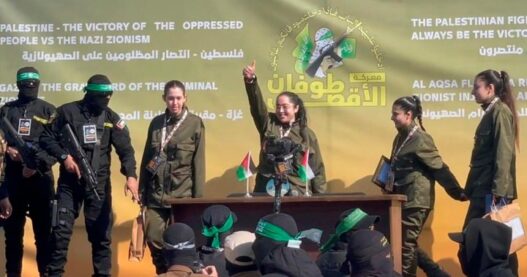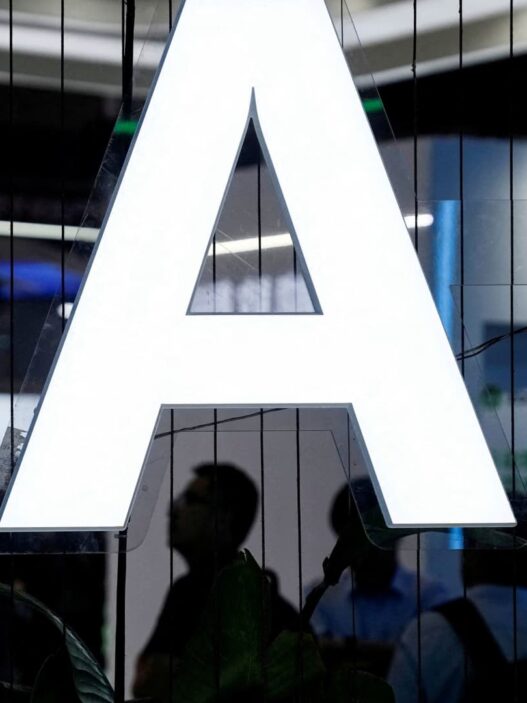Four Israeli soldiers who were held hostage by Hamas returned safely to Israel on Saturday after the militants paraded them before a crowd of thousands in Gaza City and then handed them over to the Red Cross. In return, Israel released 200 Palestinian prisoners as part of a fragile ceasefire in the Gaza Strip.
The four Israelis smiled broadly as they waved and gave the thumbs-up from a stage in Palestine Square in Gaza City, gunmen on either side of them and a crowd of thousands watching before they were led to Red Cross vehicles. They were likely acting under duress, as previously released hostages said they were held in brutal conditions and forced to record propaganda videos.
Israel’s prison service later said it had completed the release of 200 Palestinians. Among them were 121 who were serving life sentences after being convicted of deadly attacks against Israelis. About 70 have been released in Egypt, according to Qahera TV in Egypt. Egypt was a key mediator in the talks that led to the truce.
Thousands of Palestinians gathered in the West Bank city of Ramallah to celebrate the arrival of buses carrying prisoners. Many Palestinian flags or flags of different political factions.

When the four Israelis were released, hundreds of people cheered in Tel Aviv’s Hostage Square as they watched the drama unfold on a big screen television.
“I had goosebumps watching it,” said Abiv Berkowitz, an onlooker. “I just want the war to end.”
The freed hostages were taken to an Israeli army base, where they were reunited with their parents, and can be seen in photos of them emotionally embracing.
When they arrived by helicopter at the Tel Aviv hospital, thousands of people dancing and celebrating outside looked up to see them knocked down.
Israel insists on releasing civilian hostages
Prime Minister Benjamin Netanyahu’s office later said that Israel would not allow displaced Palestinians to begin their return to northern Gaza, which was expected to begin on Sunday, because a civilian hostage who was supposed to be released by Hamas had not been released.

Get daily national news
Get the day’s best news, political, economic and current affairs headlines, to your inbox once a day.
She said Israel would not allow Palestinians to begin their return to northern Gaza, which was expected to begin on Sunday, until Arbel Yehud was released.

A senior Hamas official said the group informed mediators that Yehud would be released next week.
Meanwhile, an Egyptian official involved in the negotiations described the matter as a “minor issue” that it is working to resolve. Both officials spoke on condition of anonymity because they were not allowed to discuss the matter publicly.
This was the second exchange between Israel and Hamas since the ceasefire began in the Gaza Strip last weekend. The excitement in Israel was palpable, with TV stations filled with live reports from smiling news anchors and reporters interviewing the hostages’ ecstatic friends and relatives.
The truce aims to end the bloodiest and most destructive war between Israel and the armed group. It has struck a fragile deal so far, with air and missile strikes subsiding and allowing increased aid to flow to the small coastal territory.
When the ceasefire began on Sunday, three hostages were released by the militants in exchange for 90 Palestinian prisoners and all the women and children.
Who are the soldiers and prisoners being released?
The four Israeli soldiers, Karina Ariev, 20, Daniela Gilboa, 20, Nama Levy, 20, and Albag, 19, were captured in Hamas on October 7, 2023, the attack that sparked the war.
In return, Israel agreed to release 200 prisoners, including 121 who were serving life sentences, according to a list released by Hamas.
Among the most high-profile militants released were Mohammed Udeh, 52, and Will Kasem, 54, both from East Jerusalem. They have been accused of carrying out a series of deadly Hamas attacks against Israelis, including a bombing in a cafeteria at Jerusalem’s Hebrew University in 2002 that killed nine people, including five American citizens.
Of the 70 expelled to Egypt, some may eventually go to other countries, with Algeria, Tunisia and Turkey all expressing a willingness to transfer them, according to Abdullah Al-Zaghari, head of a Palestinian prisoner advocacy group.
The four released Israeli soldiers were being transferred from the Nahal Oz base near the border with Gaza when Palestinian militants overran it, killing more than 60 soldiers there. A fifth soldier in her unit, Agam Berger, 20, was kidnapped with them but was not included in the list.
“This is huge,” said Gaza City resident Radwan Abu Rawya, one of thousands who watched the hostages in Palestine Square.
“People have forgotten the war and destruction and are celebrating,” he said.
In a televised statement, IDF spokesman Admiral Daniel Hagari criticized what he called the “cynical” display of young women by Hamas before their release.
He also said that Israel is concerned about the fate of the youngest hostages – KFIR and Ariel Bibas – and their mother Shiri. Kfir Bibas celebrated his second birthday in captivity earlier this month.
Hajjari said the army was committed to bringing all the hostages home.
What’s next in the ceasefire deal?
Israel was expected to begin retreating from the Netzarim Corridor—the east-west road that divides Gaza in two—and allow Palestinians displaced in the south to return to their former homes in the north for the first time since the start of the war.
But that seems to be on hold pending Yehoud’s launch.
The Hamas-run Interior Ministry said earlier that displaced Palestinians would be allowed to return to northern Gaza starting Sunday.
What happens after the initial six-week deal phase is uncertain, but many hope it will bring an end to the war that has flattened large swathes of Gaza, struck the vast majority of its population and left hundreds of thousands of people at risk of starvation.
The conflict began with a Hamas-led cross-border attack on October 7, 2023, when Palestinian militants killed about 1,200 people, mostly civilians, and took about 250 others hostage.
More than 100 hostages were released in a week-long truce the following month. But dozens remained in captivity for more than a year without contact with the outside world. Israel believes that at least a third of the more than 90 prisoners still inside Gaza were killed in the initial attack or died in captivity.
While many in Tel Aviv Square rejoiced after the four soldiers were released on Saturday, some are concerned about the fate of those still in captivity.
“It’s hard to still be there,” said Yoni Collins, a family friend of Berger, the fifth soldier taken from the Nal Oz base.
“There were five girls, four girls out and now she’s in there alone,” he said. “We’re just waiting for her to come home.”
Israel’s air and ground war, one of the bloodiest and most destructive in decades, has killed more than 47,000 Palestinians, according to local health officials, who do not say how many militants there are. They say women and children make up more than half of the deaths.














